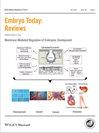Jihee Sohn, Rachel M. Brick, Rocky S. Tuan
下载PDF
{"title":"From embryonic development to human diseases: The functional role of caveolae/caveolin","authors":"Jihee Sohn, Rachel M. Brick, Rocky S. Tuan","doi":"10.1002/bdrc.21121","DOIUrl":null,"url":null,"abstract":"<p>Caveolae, an almost ubiquitous, structural component of the plasma membrane, play a critical role in many functions essential for proper cell function, including membrane trafficking, signal transduction, extracellular matrix remodeling, and tissue regeneration. Three main types of caveolin proteins have been identified from caveolae since the discovery of caveolin-1 in the early 1990s. All three (Cav-1, Cav-2, and Cav-3) play crucial roles in mammalian physiology, and can effect pathogenesis in a wide range of human diseases. While many biological activities of caveolins have been uncovered since its discovery, their role and regulation in embryonic develop remain largely poorly understood, although there is increasing evidence that caveolins may be linked to lung and brain birth defects. Further investigations are clearly needed to decipher how caveolae/caveolins mediate cellular functions and activities of normal embryogenesis and how their perturbations contribute to developmental disorders. Birth Defects Research (Part C) 108:45–64, 2016. © 2016 Wiley Periodicals, Inc.</p>","PeriodicalId":55352,"journal":{"name":"Birth Defects Research Part C-Embryo Today-Reviews","volume":"108 1","pages":"45-64"},"PeriodicalIF":0.0000,"publicationDate":"2016-03-17","publicationTypes":"Journal Article","fieldsOfStudy":null,"isOpenAccess":false,"openAccessPdf":"https://sci-hub-pdf.com/10.1002/bdrc.21121","citationCount":"27","resultStr":null,"platform":"Semanticscholar","paperid":null,"PeriodicalName":"Birth Defects Research Part C-Embryo Today-Reviews","FirstCategoryId":"1085","ListUrlMain":"https://onlinelibrary.wiley.com/doi/10.1002/bdrc.21121","RegionNum":0,"RegionCategory":null,"ArticlePicture":[],"TitleCN":null,"AbstractTextCN":null,"PMCID":null,"EPubDate":"","PubModel":"","JCR":"Q","JCRName":"Medicine","Score":null,"Total":0}
引用次数: 27
引用
批量引用
Abstract
Caveolae, an almost ubiquitous, structural component of the plasma membrane, play a critical role in many functions essential for proper cell function, including membrane trafficking, signal transduction, extracellular matrix remodeling, and tissue regeneration. Three main types of caveolin proteins have been identified from caveolae since the discovery of caveolin-1 in the early 1990s. All three (Cav-1, Cav-2, and Cav-3) play crucial roles in mammalian physiology, and can effect pathogenesis in a wide range of human diseases. While many biological activities of caveolins have been uncovered since its discovery, their role and regulation in embryonic develop remain largely poorly understood, although there is increasing evidence that caveolins may be linked to lung and brain birth defects. Further investigations are clearly needed to decipher how caveolae/caveolins mediate cellular functions and activities of normal embryogenesis and how their perturbations contribute to developmental disorders. Birth Defects Research (Part C) 108:45–64, 2016. © 2016 Wiley Periodicals, Inc.
从胚胎发育到人类疾病:小窝/小窝蛋白的功能作用
小泡是一种几乎无处不在的质膜结构成分,在许多正常细胞功能中起着至关重要的作用,包括膜运输、信号转导、细胞外基质重塑和组织再生。自20世纪90年代初发现caveolin-1以来,已经从caveolae中鉴定出三种主要类型的caveolin蛋白。这三种基因(Cav-1、Cav-2和Cav-3)在哺乳动物生理中起着至关重要的作用,并能影响多种人类疾病的发病机制。尽管自发现以来,小窝蛋白的许多生物活性已经被发现,但它们在胚胎发育中的作用和调控在很大程度上仍然知之甚少,尽管越来越多的证据表明,小窝蛋白可能与肺和脑出生缺陷有关。显然需要进一步的研究来解释小泡/小泡蛋白如何介导正常胚胎发生的细胞功能和活动,以及它们的扰动如何导致发育障碍。出生缺陷研究(C辑)108:45-64,2016。©2016 Wiley期刊公司
本文章由计算机程序翻译,如有差异,请以英文原文为准。

 求助内容:
求助内容: 应助结果提醒方式:
应助结果提醒方式:


